Medicare Part D network preferred pharmacies see an increase in DIR fees

Pharmacy Benefit Managers (PBMs) have recently implemented several cost-cutting measures in response to a federal mandate to reduce Medicare spending. One key area where PBMs have sought to achieve additional cost savings is from pharmacies who have signed up for preferred status in the payer's Medicare Part D network.
Increasingly, PBMs have begun calculating Direct and Indirect Remuneration (DIR) fees in the reimbursement rates for these preferred pharmacies. DIR fees are a percentage or a flat fee applied to the reimbursement for a Medicare Part D prescription. DIR fees are not applied at the point of reimbursement; rather, they are applied post-reimbursement, usually in an EOB statement.
While DIR fees may only reflect a nominal percentage of a typical reimbursement, the fee can run into the hundreds of dollars on some high-end prescriptions. In some cases, pharmacists may actually lose money on a reimbursement if the DIR fee ends up being greater than the reimbursement amount for a filled prescription.
Currently, there is no way to track DIR fees during the prescription filling process. NCPDP standards do not provide a field to track DIR fees. Similarly, MPS&A’s pharmacy management systems and services do not monitor or gather data on DIR fees.
There are a number of actions you can take to minimize the impact of DIR fees on your pharmacy:
- Educate yourself so that you fully understand how DIR fees can impact your business
- Carefully review billing statements for DIR fees and consider steering Medicare Part D patients to medications with lower DIR fees
- Consider enrolling in a Medicare reimbursement monitoring program with our partner vendor, iMedicare. iMedicare can track your status as a preferred pharmacy with Medicare Part D plans and can display potential DIR fees when you perform a benefit plan comparison. For more information, please contact an iMedicare representative at 704.769.0540.
 |
|||
